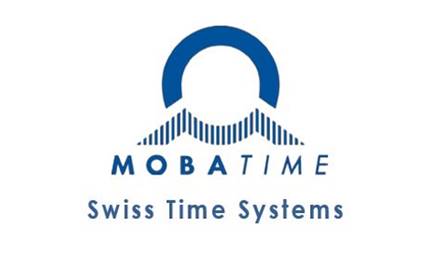The Grand Rapids clock company’s Swiss partner is famous for design and technology.
Lumichron builds and restores public clocks, and is a U.S. distributor of MobaTime Swiss-made clock systems, including analog and digital displays with time-code delivery by means of impulse, LAN/WAN or wireless. MobaTime is a trademark of Moser-Baer Ltd., of Switzerland, manufacturer of the long-famous Swiss railway station clocks. MobaTime manufactures extremely accurate NTP time-servers along with master clocks for clock systems in bus and rail transit stations, airport terminals, schools and universities, hospitals and industrial settings.
Lumichron, founded and operated by Ian and Karen Macartney at 2215 29th St. SE, produces public clocks for customers throughout North America and Europe. A high-profile Lumichron project locally took place in November, with the company’s restoration of the 1926 Seth Thomas clock atop the façade of the five-story Kingsley Building on Lake Drive SE in Eastown. The building, owned by Bazzani and Associates, was recently added to the National Register of Historic Places.
The new Amtrak station in Grand Rapids features two illuminated public clocks built by Lumichron, as does the original Farmers Market on Fulton Street. But those are “unusual,” said Ian Macartney, “because most of what we (make), we ship” out of West Michigan. And most orders are custom-built, using MobaTime components, for new high-end commercial construction where impeccable design and flawless performance are major requirements.
According to swissworld.org, the Swiss government’s official information website, the Swiss federal railway clock, or “SBB clock,” has become a design classic since created in 1940. It was selected by both the London Design Museum and the Museum of Modern Art in New York as one of the most iconic examples of 20th century design. The simple but extremely well-engineered clock has been standing on all the passenger platforms of the Swiss federal railway system for more than 70 years. People who have traveled in Switzerland are familiar with it, and an SBB clock was in a scene from “The Bourne Identity.” Apple even entered into a licensing agreement with the Swiss railway system to allow the clock’s image on iPhones and iPads.
All the clocks at each Swiss railway station must run synchronously, receiving an electrical impulse from MobaTime’s central master clock at each full minute.
Lumichron engineers, designs and assembles high-quality, heavy-duty commercial clocks and clock systems including illuminated electric clocks, four-sided tower clocks, bracket clocks and façade clocks, using MobaTime clock works. Lumichron employs four, counting the two Macartneys.
Ian Macartney noted that large public clocks were once a common fixture in American life, but that has changed. At American airports, for example, the flight information display boards are a critically important reference point for passengers, but the actual time — in a digital readout — is usually virtually hidden down in a corner of the display.
Macartney said he and Karen decided to exhibit at the architects’ show in Chicago because they are “trying to promote public time, and the concept of using clocks on buildings and facilities.”
“American airports have virtually no clocks,” he said, but “you could travel around the world and most airports have lots of clocks.”
“It’s beyond me how the new Delta terminal in New York could put $2 billion into a terminal and not have a single clock. Or, locally, the $32 million new Kalamazoo terminal — and not a single clock.”
Some may think clocks are no longer necessary since everyone carries a mobile phone.
“Well, how convenient is it to be carrying your bags (in an airport), in a hurry, and fish out your cell phone and look at the time, when you could just glance up and there’s the time right in front of you? And you can tell exactly how much time you have left, in a nanosecond.”
The Macartneys became known in the West Michigan business community for a successful business they started in 1984 called NeonAmericana, which designed and produced a variety of neon-related products, ranging from architectural neon and neon art to neon signage and neon clocks.
Around 1988, they registered the trade name Lumichron and began producing indoor wall clocks, but there were also some outdoor clocks ranging in size from 24 to 42 inches in diameter. All the clocks incorporated neon illumination or embellishment.
“Ian has always been the sole designer/engineer,” said Karen.
Key customers for NeonAmericana were large U.S. retailers, including Redwing shoes and Harley Davidson motorcycles, which used the neon signage at point-of-purchase displays.
“At one time, we were shipping a hundred of these items every week, but once the Chinese copied our stuff, that kind of made a big dent in things, because they would sell it for just pennies on the dollar” compared to the NeonAmericana made-in-the-USA products, she said.
She said the quality of the Chinese neon signs was very much inferior, “but money talks. Quality isn’t always such a big deal when things are so much cheaper.”
“When the Chinese came in and wiped out that market, we had to think of something else,” said Ian.
Then he learned about the European digital clock controls and movements, “and I thought, this is the way to go.”
He began researching the market for tower clocks and identifying suppliers of components. In about 2005, the Macartneys won a major order for about 100 outdoor/commercial clocks, 36 inches in diameter, for the Swiss luxury watch manufacturer Tag Heuer. The clocks were a marketing strategy, mounted on the exterior of Tag Heuer retail stores around the world.
Karen said that by the time the neon business was phased out (around 2009), their commercial clock business “had taken off. We have realized between 25 and 40 percent sales growth per year since.”
Today, “everything we build is custom made-to-order” and “it’s very difficult to get that type of work from China,” said Ian.
“We are kind of a model for businesses dealing with overseas competition,” he added.


